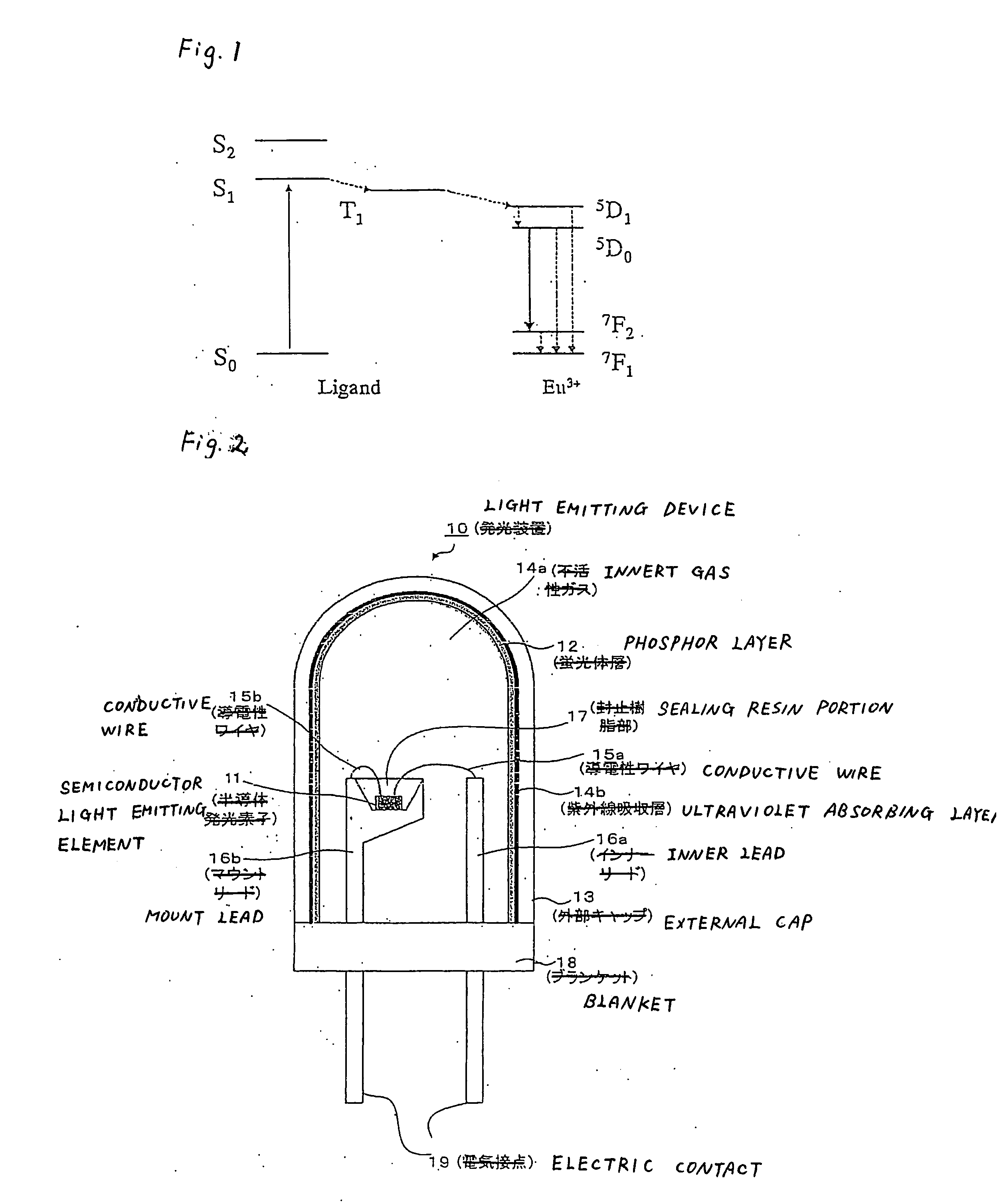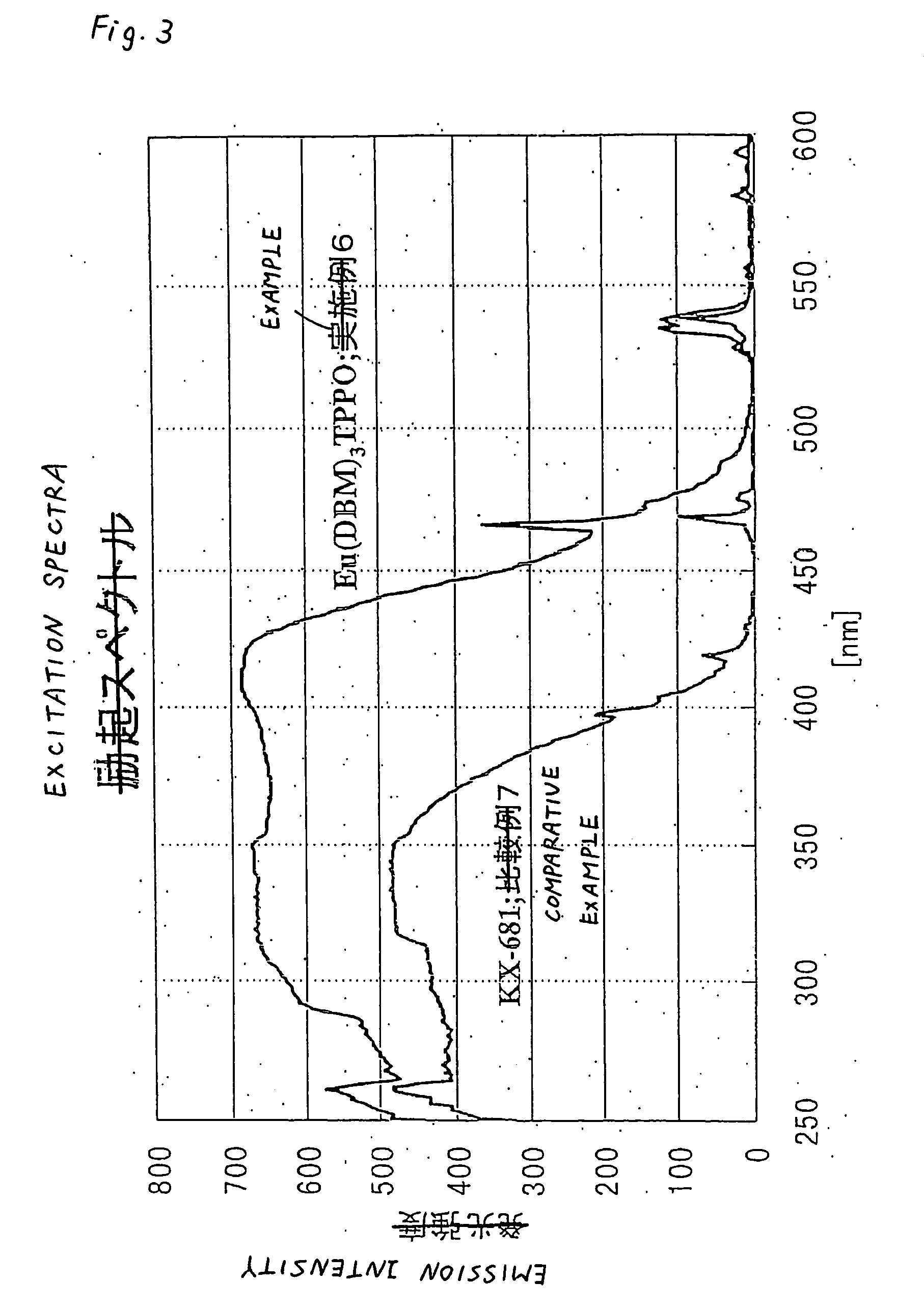Light emitting device and lighting device using it, image display unit
a technology of light emitting device and image display unit, which is applied in the direction of discharge tube/lamp details, discharge tube luminescent screen, discharge tube/lamp details, etc., can solve the problem of insufficient emission intensity, led or ld is difficult to stably produce the emission wavelength with a high degree of accuracy, and the emission efficiency is significant. the effect of high emission intensity
- Summary
- Abstract
- Description
- Claims
- Application Information
AI Technical Summary
Benefits of technology
Problems solved by technology
Method used
Image
Examples
example 1
[0086] Synthesis of Eu(TTA)3(TPPO)2
[0087] 0.67 g (3.0 mmol) of 4,4,4-trifluoro-1-(2-thienyl)-1,3-butanedione (H-TTA), 0.56 g (2.0 mmol) of triphenylphosphine oxide (TPPO) and 0.32 g (3.0 mmol) of 2,2′-iminodiethanol were dissolved in 40 ml of isopropanol. To this solution, a solution obtained by dissolving 0.37 g (1 mmol) of europium chloride (III) hexahydrate in 20 ml of a mixed solvent of water / isopropanol (1 / 4) was added dropwise at room temperature taking 2 hours, and stirring was further continued at room temperature for 1 hour. A precipitate formed was filtered by suction, and washed with water and isopropanol. The resulting light yellow powder was dried under vacuum at 50° C. to obtain a desired product Eu(TTA)3(TPPO)2 represented by the following structural formula. The melting point of this complex was from 248° C. to 251° C.
example 2
[0088] Synthesis of Eu(TTA)3Phen
[0089] 6.67 g (30 mmol) of H-TTA, 1.98 g (10 mmol) of 1,10-phenanthroline (Phen) monohydrate and 3.16 g (30 mmol) of 2,2′-iminodiethanol were dissolved in 500 ml of ethanol. To this solution, a solution obtained by dissolving 3.67 g (10 mmol) of europium chloride (III) hexahydrate in 200 ml of ethanol was added dropwise at room temperature taking 4 hours, followed by further standing at room temperature for several hours. Then, a precipitate formed was filtered by suction, and washed with ethanol. The resulting light yellow powder was dried under vacuum at 50° C. to obtain a desired product Eu (TTA)3Phen represented by the following structural formula.
[0090] Elemental analysis of this complex showed 43.33% C, 2.36% H and 2.78% N, which were approximately identical to calculated values, 43.43% C, 2.02% H and 2.81% N. Further, the melting point of this complex was from 242° C. to 243° C.
[0091] For the resulting Eu(TTA)3Phen complex, a powder X-ray di...
example 3
[0095] Synthesis of Eu(TTA)3IQNO
[0096] 0.67 g (3 mmol) of H-TTA, 0.15 g (1 mmol) of isoquinoline-N-oxide (IQNO) and 0.32 g (3 mmol) of 2,2′-iminodiethanol were dissolved in 25 ml of ethanol. To this solution, a solution obtained by dissolving 0.37 g (10 mmol) of europium chloride (III) hexahydrate in 20 ml of ethanol was added dropwise at room temperature, and then, 15 ml of water was added, followed by stirring at room temperature for several hours. A precipitate obtained was filtered by suction, and washed with water. The resulting light yellow powder was dried under vacuum at 50° C. to obtain a desired product Eu(TTA)3IQNO represented by the following structural formula. The melting point of this complex was from 249° C. to 251° C.
PUM
| Property | Measurement | Unit |
|---|---|---|
| excitation wavelength | aaaaa | aaaaa |
| excitation wavelength | aaaaa | aaaaa |
| peak wavelength | aaaaa | aaaaa |
Abstract
Description
Claims
Application Information
 Login to View More
Login to View More - R&D
- Intellectual Property
- Life Sciences
- Materials
- Tech Scout
- Unparalleled Data Quality
- Higher Quality Content
- 60% Fewer Hallucinations
Browse by: Latest US Patents, China's latest patents, Technical Efficacy Thesaurus, Application Domain, Technology Topic, Popular Technical Reports.
© 2025 PatSnap. All rights reserved.Legal|Privacy policy|Modern Slavery Act Transparency Statement|Sitemap|About US| Contact US: help@patsnap.com



